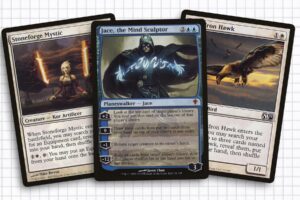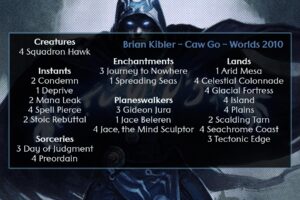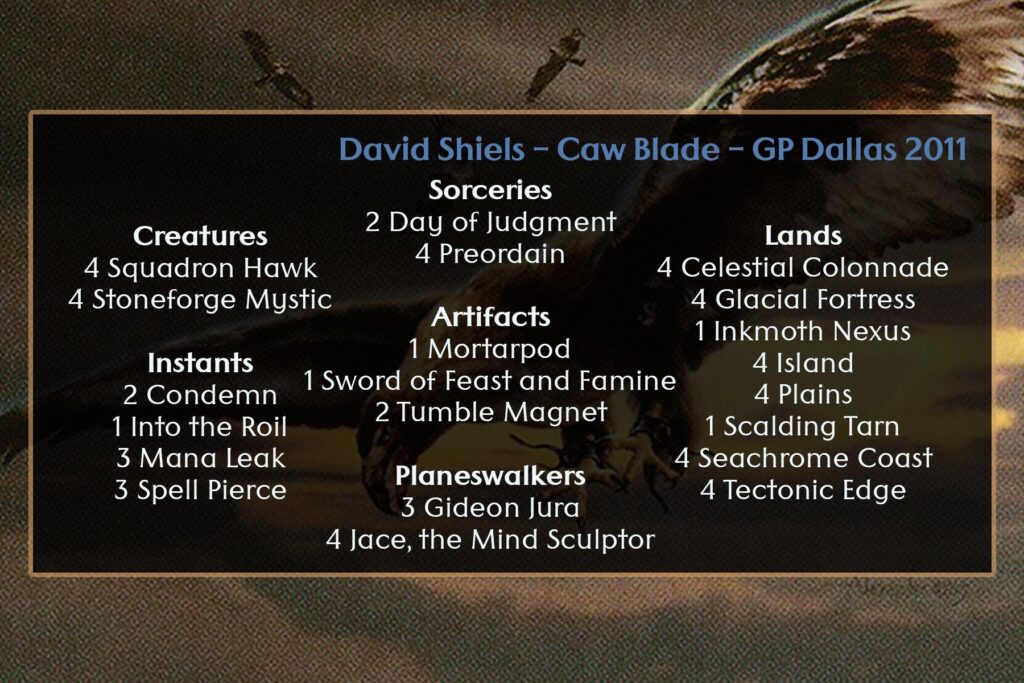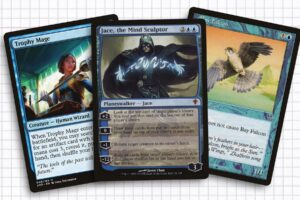I bought a Jace, the Mind Sculptor.
The Worldwake printing to be specific. For most people, that is not nearly as impressive as it might have been in the glory days of Mirrodin Besieged Standard. Or in April 2013, when it spiked because we thought it would be unbanned in time for Modern Masters. Or in February 2018, when it actually was unbanned and proved to be safe. From there, they remained pretty pricey up until the pandemic hit and the formats Jace saw play in went on pause long enough for some reprints and formats like Modern to fundamentally change enough that the price has dropped. Is Jace, the Mind Sculptor a relic of a different time? Am I a dinosaur, with the snowflakes crystalizing on my back?
Sorry, I wandered off a bit from my original point. You see, I was intending on buying a copy of Jace if I won either of the categories I was nominated for in the MTG Content Creator Awards. But as time went on and the results continued to get delayed, I thought to myself, “I got nominated, that’s already something to celebrate.” Maybe it’s better stated, I treated myself to a Jace, the Mind Sculptor, because it was a prize that meant something to me, for recognition I very much appreciated.
Regardless of the price point, the card once defined Standard. I don’t care if the price is now sub $40.00 on the regular, actually owning that piece of history meant more to me than it logically should have. The day I got it, I propped it up at my desk and just stopped to look at it from time to time. This was something I did for me and I was going to turn it into an Oathbreaker deck, I even knew where I would get my inspiration.

Jace, the Mind Sculptor, Stoneforge Mystic, and Squadron Hawk. The trinity responsible for Caw Blade
“The Best Standard Format Ever.”
- Micheal J. Flores, Yo! MTG Taps Episode 66 part 2
For those who need the cliff notes, Jace, the Mind Sculptor was a card printed in Worldwake, that would go on to overtake Standard as one of the faces of the “Caw Blade” deck. The genesis of the deck was the Brad Nelson/Brian Kibler iteration, Caw-Go, which earned Brian an undefeated record on Day 1 of the Worlds 2010. The deck used the unassuming common, Squadron Hawk, to create a surprisingly consistent strategy.

The Caw-Go deck that Brian Kibler premiered at Worlds 2010
While a version of Caw Blade very well could have existed at this tournament, it wouldn’t be until the printing of Sword of Feast and Famine and Pro Tour Paris that players like Ben Stark and Brad Nelson would add four copies of Stoneforge Mystic and change things forever. Or at least the subsequent 129 days; bans came down that June. Regardless, the boogeyman had been unleashed. As someone who lived through this era, serious questions started to arise about the possibility of bans actually happening in Standard, when 32 copies of The Mind Sculptor appeared in the top eight of Grand Prix Dallas in April 2011.

Caw-Blade as it was piloted by David Shiels to win Grand Prix Dallas
While it feels like an oft repeated statistic, we had not seen bans in Standard since June of 2004, when Skullclamp was banned. Looking back at that time, I do see it as one of the best Standard formats that has ever existed. Skilled players that knew their decks and innovated when needed were prevailing, which felt different than the Jund or Faeries decks that had been successful in Standard the two previous years.
The result was an era of Magic that imprinted on me and helped to clarify how I viewed and interacted with the game. Right up front was Jace: the Mickey Mouse of Magic and the first planeswalker with four abilities. I will readily admit that I didn’t fully understand his power until I cast him in a Cube draft about four or five years ago. I’d never seen a physical copy, I’d only ever theorycrafted what he was capable of. Now that I owe one, I knew he was going to be the head of an Oathbreaker deck.

Jace, the Mind Sculptor, Trophy Mage, and Bay Falcon. The trinity, I hope to make popular in Caw Breaker.
Caw-Breaker
Early on in my tenure, I attempted to port Caw Blade into Commander. At that time I theorized that the best way to capture the archetypical components of what is essentially a midrange deck was to assemble a Bant deck with Derevi, Empyrial Tactician at the helm. And at the time, Derevi had built up a bit of a reputation for being obnoxious, a perfect reputation for what I was trying to create. Now facing the challenge of bringing Caw Blade to Oathbreaker, I had to make it mono blue.
Oathbreaker:
Signature Spell:
Planeswalkers:
Creatures:
- Aven Envoy
- Bay Falcon
- Deadeye Quartermaster
- Esior, Wardwing Familiar
- Trinket Mage
- Trophy Mage
- Zephyr Falcon
Sorceries:
Instants:
- Aetherize
- Engulf the Shore
- Force Spike
- Lose Focus
- Mana Leak
- Miscalculation
- Perplexing Test
- Spell Pierce
- Stubborn Denial
Artifacts:
- Basilisk Collar
- Batterskull
- Shadowspear
- Sword of Feast and Famine
- Sword of Fire and Ice
- Sword of War and Peace
- Vedalken Orrery
Enchantments:
Lands:
- 15 Island
- Bad River
- Bant Panorama
- Desert of the Mindfu
- Esper Panorama
- Flood Plain
- Grixis Panorama
- Halimar Depths
- Lonely Sandbar
- Remote Isle
- Seat of the Synod
Firstly, I made Rise of Eagles my signature spell. We’re Caw Blade, we always need our birds and unfortunately, Crow Storm is not a legal spell. The use of Rise of Eagles as my signature spell is also a nod to my want to be more casual. Jace, the Mind Sculptor is going to raise some eyebrows, even if he logically can’t be as potent in a multiplayer format as he was everywhere else. But I think the amount of choices he allows for – be it who to target with the first ability, how you stack your top decks with the second ability, the set back in tempo the third ability can be, or just how definitive of a win his ultimate can set up – ready allows him to have a place in a multiplayer game, rather well.
Since we can’t have actual Stoneforge Mystic, I substituted in Deadeye Quartermaster, Fabricate, Trinket Mage, and Trophy Mage. But I would also say that a strong element of the deck is its control spells and deck manipulation resources.This is why I’ve packed six counter spells and my mass removal is weighted towards instant speed with Aetherize, Engulf the Shore, and Perplexing Test. Additionally, even in a mono color deck, I chose to play the Mirage fetchlands and available Panoramas, because using Jace’s Brainstorm ability is most effective when you can shuffle away what you put back.
The titular Blades of this deck were also a point on strong consideration, I knew that Sword of Feast and Famine, Sword of Fire and Ice, and Sword of War and Peace were going to reside in the list, making Trophy Mage possibly the most important of my tutoring creatures. But I also knew that Basilisk Collar and Shadowspear would be useful tool box cards to allow me to change combat enough to overcome the multiplayer threats. Lastly, Batterskull is what I’m looking for with Deadeye Quartermaster and probably Fabricate. The equipment can no longer be placed into play at instant-speed, but as a historical piece of the Standard version of the deck, it only felt right.
Caw Blade will always be a touch point that I return to. It was the most impactful deck during a time when I had the most time to dedicate towards Magic, before fully diving into Commander. As Oathbreaker has become a format that I wanted to give another chance, I knew that if I owed a Jace, the Mind Sculptor, I wanted him to helm a deck. And ultimately that’s why I bought a copy of Jace. I wanted to celebrate an accomplishment and also create something near and dear to my heart. I suppose now if actually I win, I have to finish the playset, don’t I?
A lot of this article would not have solidified from an idea to a full piece if not for the efforts of Magic historical pieces, like Nizzahon’s History of Caw-Blade Decks, The Yo! MTG Taps podcast’s continued archive of episodes, Evan Erwin’s discussion of then-current events on The Magic Show, and – as always – Rhystic Studies spotlighting anything, in this case Jace, himself. Thank you to these resources and dozens of others that I mentally cataloged in my mind along the way.
Ryan Sainio (he/him) is a Graphic Designer exploring the Commander format and Magic history on a regular basis. Notable decks that value flavorful and fun gameplay over competitively optimized decks include Shattergang Eldrazi, Doran Soul Sisters, and Chatterfang ProsBloom.
MTG Content Creator Awards 2022 nominee: Format Specialty Writing & Excellence in Writing Overall

